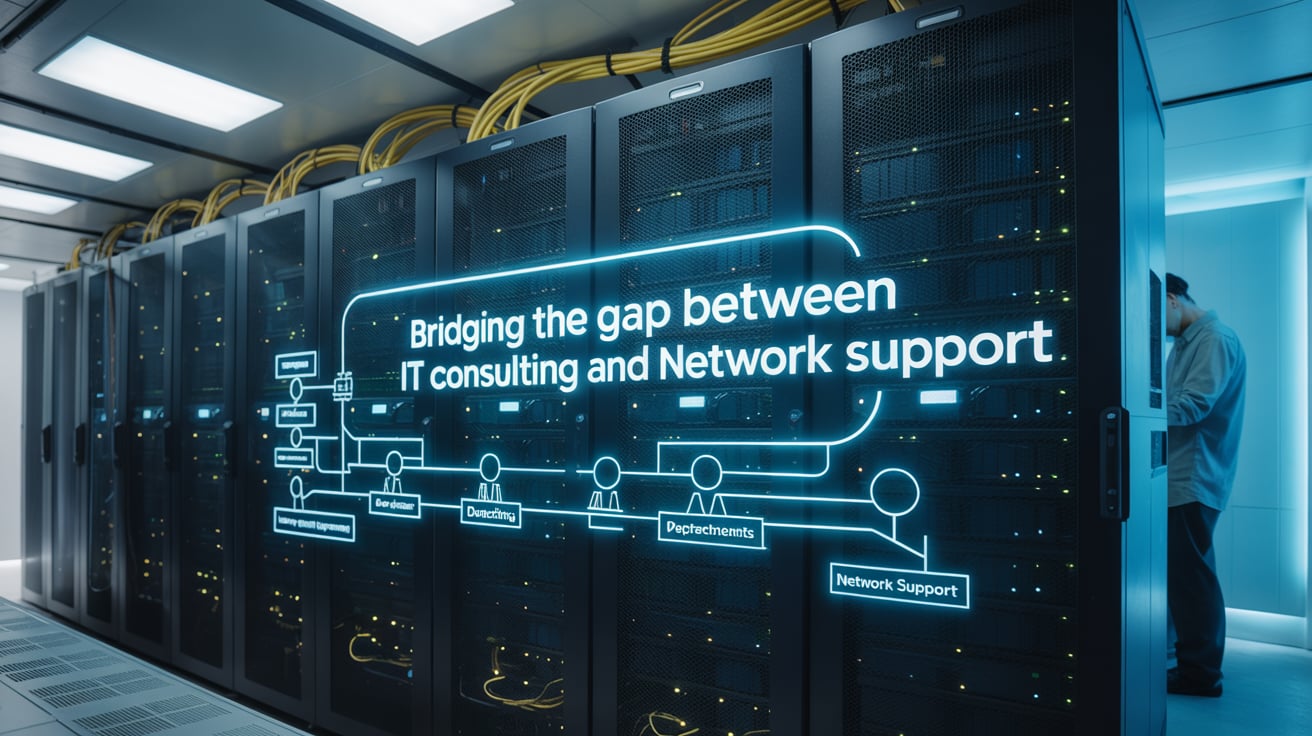Businesses today face a common problem: their IT consultants and network teams often work in isolation. This lack of collaboration can lead to miscommunication, slow processes, and fragile infrastructure that struggles under pressure. When systems fail, downtime harms both productivity and revenue.
Research shows that narrowing the gap between IT consulting and network support is critical for building robust operations. Businesses with unified teams are better prepared to handle challenges like cyber threats, system failures, or unexpected growth demands. This blog will guide you on how to align these two areas into one cohesive strategy. It covers key steps to enhance teamwork, improve infrastructure resilience, and adapt faster using modern technology.
Ready for practical solutions? Keep reading!
Aligning IT Consulting with Network Support
Bringing IT consulting and network support together demands clear communication. Strong collaboration reduces misunderstandings and enhances operational efficiency.
Identifying gaps in IT and network collaboration
IT consultants often focus on strategy, while network teams prioritize functionality. This misalignment creates gaps in infrastructure resilience and digital transformation efforts. Conflicting goals or unclear responsibilities can threaten business continuity, leaving vulnerabilities unaddressed.
Communication issues also worsen during rapid technology implementations. Network security may be neglected when IT plans fail to include technical support early. Such oversights expose organizations to risks like ineffective system integration or delayed responses to incidents.
Enhancing communication between IT consultants and network teams
Clear goals reduce confusion between IT consultants and network teams. Defined objectives guide discussions and clarify responsibilities. Sharing documentation, such as system blueprints or workflows, creates a common understanding. Regular meetings foster collaboration by allowing members to share updates or address bottlenecks quickly.
Open channels improve teamwork on large projects. Tools like Slack or Teams allow instant communication during crucial tasks. For example, businesses looking to strengthen collaboration on network projects can explore more information from TrustSphere IT for insight into effective support integration. A designated liaison for each team provides a single point of contact, cutting down delays in responses. Encouraging ongoing feedback ensures both sides remain aligned throughout project timelines. Effective communication bridges gaps that technical skills alone cannot.
Key Strategies for Building Resilient Infrastructure
Strong strategies make the backbone of any reliable infrastructure. Building resilience starts with smart planning and deliberate actions.
Implementing solution architecture consulting
Solution architecture consulting focuses on designing IT systems that align with business goals. It helps businesses create efficient infrastructures by connecting the dots between technology, processes, and people. This method pinpoints gaps in current setups and provides clear improvement plans.
By incorporating solution architecture consulting, companies can minimize risks during digital transformation. To learn how expert guidance fits into strategic IT planning, businesses can consult with NexaGuard for IT support tailored to infrastructure alignment. It ensures IT systems are cost-effective while supporting long-term growth strategies. This process also enhances collaboration across teams, ensuring networks remain reliable under growing demands.
Leveraging cloud strategy for scalability
Shifting from solution architecture consulting to cloud strategies creates opportunities for flexibility and growth. Cloud systems allow businesses to adjust resources based on demand, avoiding over-provisioning or underuse of assets. This approach reduces costs while meeting real-time needs with precision.
Modern technology demands adaptability, and cloud platforms address this challenge directly. Services like AWS, Azure, and Google Cloud provide tools for the smooth integration of IT infrastructure and network support. As workloads expand, environments adapt automatically without downtime. Cloud adoption isn’t just about storage; it’s about building a business prepared for the future.
Integrating cybersecurity into IT infrastructure
Cyber threats target businesses daily, putting data and operations at risk. Strong protections should be part of all IT systems from the ground up. Firewalls, encryption methods, and access controls defend sensitive information against breaches. A multi-layered approach makes hacking harder for cybercriminals by creating multiple obstacles they must cross to succeed.
IT teams need real-time monitoring tools to detect unusual activities immediately. These tools can notify staff when something suspicious happens within networks or systems. Regularly updating software and firmware eliminates weak points that attackers exploit. Teaching employees about phishing scams reduces human errors that compromise security further, making it a team effort across the organization.
The Role of Emerging Technologies
Technology is evolving faster than ever. Businesses must embrace smart tools to stay secure and efficient.
Utilizing artificial intelligence and automation
Artificial intelligence simplifies complex IT processes. It can foresee network failures before they happen, saving time and money. Automation manages repetitive tasks like software updates or backups, reducing human error. Businesses can focus on growth while machines handle routine operations.
Advanced technology improves infrastructure resilience by analyzing vast amounts of data quickly. For example, automated systems detect vulnerabilities in real-time, strengthening network security. This method supports faster problem solving and improved risk management.
Adopting zero trust for enhanced security
Zero trust enhances network security by requiring verification at every step. It assumes no user or device is trustworthy without validation, even within the internal infrastructure. Businesses adopting this model reduce risks tied to unauthorized access or insider threats.
Multi-factor authentication and least-privilege access are central. These tools restrict data exposure while ensuring operations remain secure. For managed IT services, zero trust promotes better control over resources across digital changes and cloud strategies. Integrating these practices with new technologies ensures a safer IT framework overall.
Measuring Success in IT and Network Integration
Clear goals guide progress. Regular checks help spot gaps and drive results.
Key performance indicators for resilient infrastructure
Strong infrastructure keeps businesses steady during disruptions. Measuring its resilience needs clear, practical indicators.
- System Uptime
Track how often critical systems stay functional. High uptime reflects strong reliability and efficiency. - Incident Response Time
Monitor how fast IT teams resolve issues. Faster responses limit downtime and protect key operations. - Infrastructure Capacity Testing Results
Examine infrastructure capacity to adapt to sudden demand changes. Flexibility shows readiness for growth or pressure. - Risk Assessment Reports
Evaluate known vulnerabilities regularly. A lower risk score indicates a solid defense strategy. - Network Latency Metrics
Measure delays in data transmissions across your network. Lower latency ensures faster communication within systems. - User Downtime Feedback
Gather insights from employees on system outages. Frequent complaints highlight weak spots needing fixes. - Security Breach Frequency
Count any unauthorized access attempts or data breaches over time. Fewer incidents signal stronger cybersecurity measures. - Cost of Downtime Analysis
Calculate financial losses during outages using real-time data. Reduced costs point to better continuity planning. - Backup and Recovery Times
Assess how quickly data restoration is possible after failures. Shorter times mean more effective disaster recovery plans. - Monitoring Alerts Correlation Rate
Check if alerts lead to resolved issues efficiently without false alarms causing confusion or delays in response teams’ actions!
Continuous monitoring and optimization
Continuous monitoring keeps your IT systems and networks resilient. Improving performance strengthens efficiency, minimizes risks, and ensures smooth operations.
- Perform real-time tracking of hardware and software to detect vulnerabilities before they escalate into crises.
- Use automated tools to track system health, reducing manual intervention and cutting response times in half.
- Analyze network traffic regularly to identify bottlenecks slowing down processes or causing downtime for end users.
- Measure critical data points such as uptime, incident resolution speed, and system load to consistently evaluate infrastructure resilience.
- Conduct monthly audits to assess if current technologies align with long-term goals for technological progress and security demands.
- Fix minor glitches immediately by adjusting configurations to lower the chances of recurring issues affecting business continuity.
- Test disaster recovery protocols at least twice a year to ensure rapid restoration during outages or external attacks targeting cybersecurity gaps.
Conclusion
Bridging IT consulting and network support builds stronger systems. It creates infrastructure that adapts to change, handles pressure, and prevents risks. By focusing on clear strategies, businesses can stay secure and grow steadily. Stronger connections between teams lead to smoother operations. Resilient infrastructure isn’t just a goal; it’s a necessity in the digital age.





























